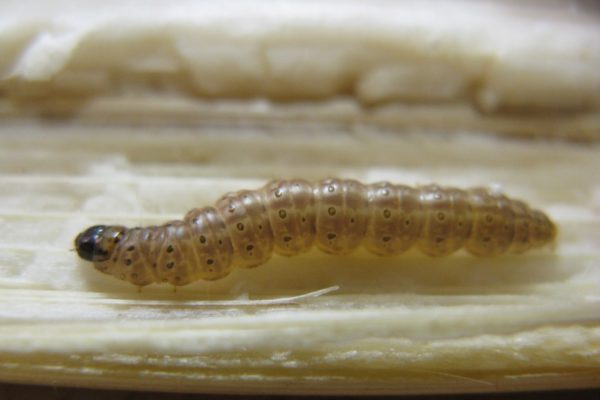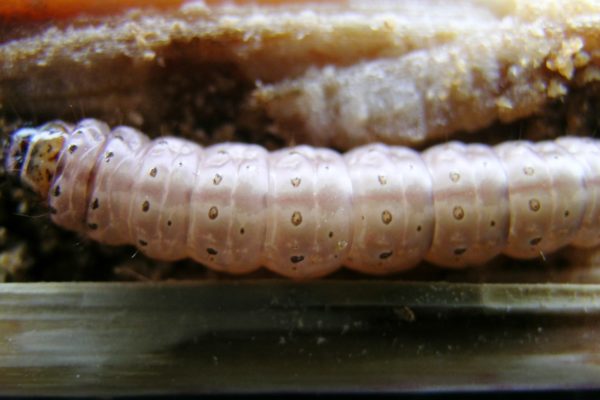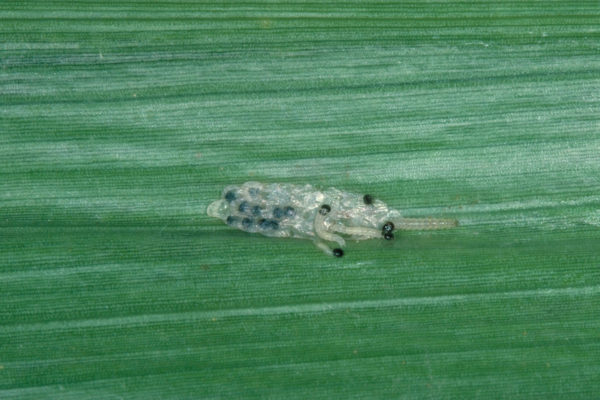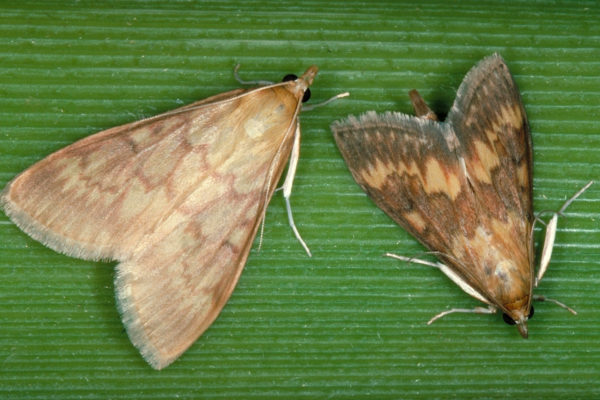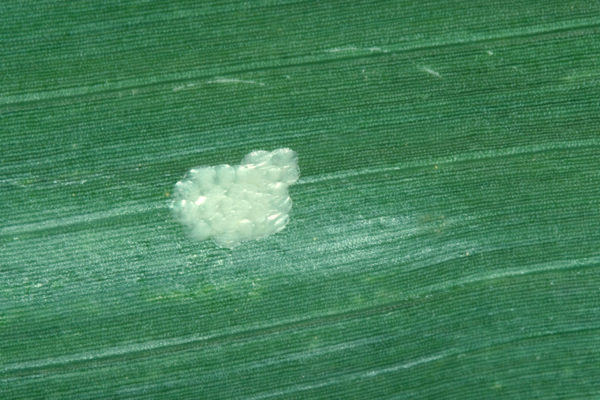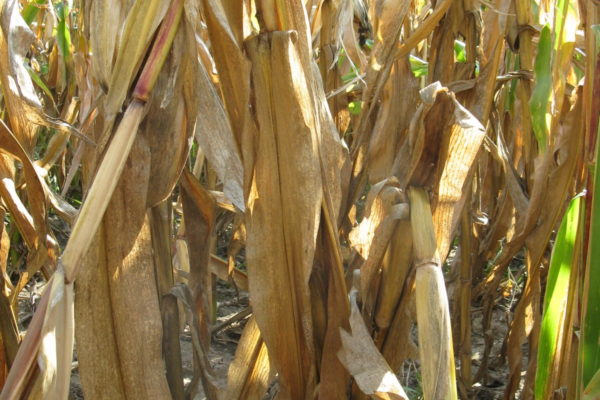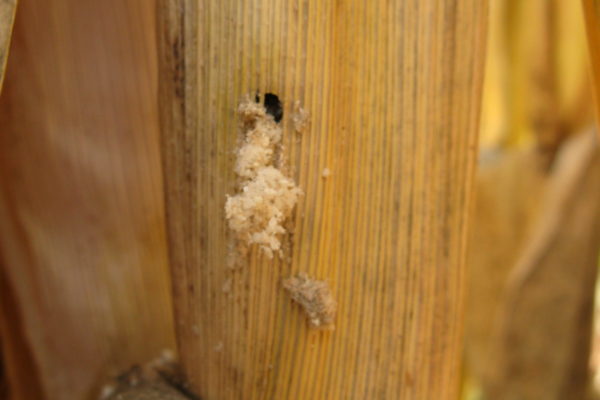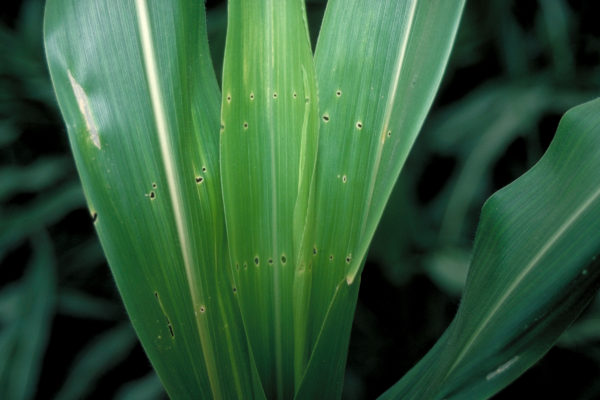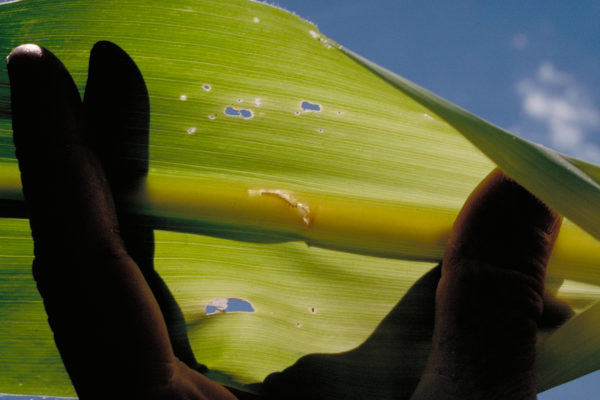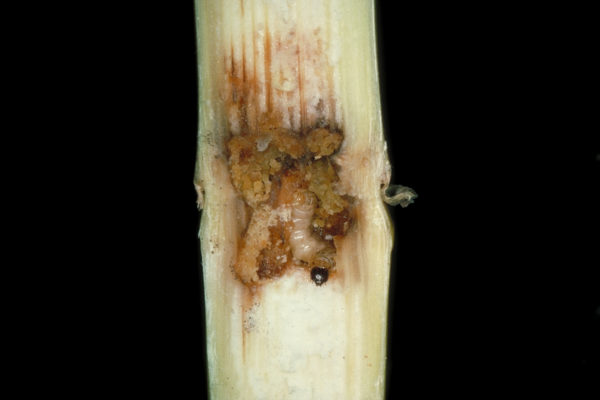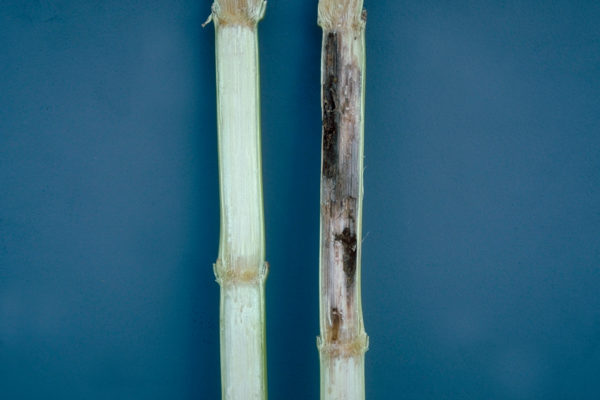The European corn borer (ECB), Ostrinia nubilalis, is one of the most destructive insect pests of field, seed and sweet corn, and is an increasing concern on peppers, potatoes, hops and other host crops in Canada. ECB is distributed from the southern portions of the Prairie provinces to the Maritimes, generally wherever corn is grown. ECB was introduced into North America in 1910 from a central European broom factory. It was first reported in Ontario in 1920, 1925 in New Brunswick, 1926 in Quebec, 1929 in Nova Scotia, 1948 in Manitoba, 1949 in Saskatchewan and 1956 in Alberta (was eradicated but re-appeared in 1980).
European corn borer can reduce yield of corn, increase harvest time, and reduce grain quality due to disease and mycotoxin contamination. Some studies have shown that one ECB per plant could reduce yield by 3 to 5 %, and greater reductions can be expected under high corn borer pressure.
Identification
Egg masses
ECB egg masses usually contain 15-30 eggs and are commonly laid on the underside of the leaf near the midrib. Eggs are flat and look like overlapping fish scales. Freshly laid egg masses are white and as they near hatching, the black head capsule of the larva is visible through the shell (blackhead stage).
ECB adult
ECB adult moths are tan (female) or brown (male) and have wavy lines on their wings. The female moths are slightly larger than the males.
ECB larvae
ECB larvae are whitish cream with a black head. There are five instars. Older instars (3rd-5th) have black spots along their body surrounded by a black halo.
Life Cycle
The corn borer undergoes four stages: egg, larva, pupa and adult for each generation. Corn damage is caused solely the larval stage. The earliest instars feed on the leaves and tassel of the plants while the later instars tunnel into the plant. ECB overwinters as a full-grown larva (5th instar) in corn (stalks and cob residues, weeds and others). Mature 5th instar larvae diapause as an inactive pupa inside the lower portion of the corn stalk left on the surface after harvest. The pupa matures in the spring, emerging as an adult moth. Moth flights take place as early as mid May until mid September.
Adult moths leave the corn residue after emergence and fly to areas of dense, grassy vegetation, such as roadside ditches or along fencerows to drink water, rest, and mate. A mated female will then find a corn crop (or other host crop) to lay eggs.
Egg masses are laid on the underside of corn leaves, usually near the midrib. Egg masses usually contain 15-30 eggs. The eggs are white and flat and look like overlapping fish scales. As the larvae mature inside the egg, the black head capsule becomes visible, called the “blackhead stage”. Eggs hatch within 3-7 days after being laid depending on temperature.
European corn borer undergoes 1-3 generations per year in Canada, depending on latitude. In regions with one generation per year (univoltine), adult moths emerge from mid-June to August. In regions with two generations per year (bivoltine), moths of the first generation emerge from late May to July and those of the second generation emerge from late July to early September. In hot years, a third generation may partially develop in October. This is often referred to as a “suicide” generation since most of the larvae will not develop sufficiently to survive the winter.
Click images above to view full image.
Injury to Corn
Early to Mid-Season ECB Damage (on V6 Stage corn and older)
- Window-pane effect – small circular feeding areas on the leaf where the first instar larvae did not feed all the way through but left a thin layer of leaf tissue
- Shot-gun effect – as the larvae develop, the size of the holes in the leaves get larger and the first and second instar larvae are able to feed completely through the leaf. Feeding pattern becomes apparent when the corn leaves extend out of the plant whorl.
- Tunnelling – entry points of the third and fourth instars often have excrement or “frass” around them. Larva will enter through the midrib or at the base of the leaf axil to pupate or will form a cocoon on the leaves or tassel. This can result in significant physiological yield loss by interfering with the transportation of nutrients and water to the stalk and leaves.
- lodged plants may also increase as a result of weakened stalks and increased stalk rot disease.
Mid to Late-Season ECB Damage (by second generation ECB or in regions with only one generation per year):
- considered to be the most damaging to corn.
- pay attention to late-planted fields or fields that are pollinating since these are most attractive to adult moths.
- damage includes leaf feeding, stalk tunnelling, kernel feeding, ear drop, tassel breakage and shank tunnelling.
- stalk, ear rot diseases, and mycotoxins tend to be more prevalent in areas infested by second generation ECB.
Click images above to view full image.
Risk Factors
In regions that experience two generations per year, early planted corn is at higher risk of early season infestations while later planted corn is at risk of attracting second generation moths. In regions within only one generation per year, later planted corn fields are most attractive for egg laying. Organic or non-Bt corn hybrids are at higher risk. No-till or reduced tillage fields are at higher risk if corn stubble is left standing and is not shredded before winter. Regions with a high percentage of corn (50% or greater in region) and regions where one generation and two generation strains overlap are also at risk.
Best Management Practices
Scouting and Thresholds
Monitoring moth flights using pheromone traps can improve timing for scouting and insecticide applications. The Great Lakes and Maritimes Pest Monitoring Network monitors for ECB activity in the region and can help to indicate when moth flights are taking place. Anyone interested in monitoring for ECB in their fields can contact their provincial entomologist for more information on which traps and pheromone lures to use in your area.
Early-season moths are attracted to tall, early planted corn fields while second-generation ECB female moths are attracted to late-planted fields that are silking/tasselling later than normal.
Examine a minimum of five sets of 20 plants (100 plants per field). Avoid the field edge as infestations will be highest in these areas and do not represent what the infestation is like throughout the field.
For early to mid season scouting — Scout the earliest planted fields first that are V6 stage or older. Plants younger than V6 have a natural chemical that prevents ECB larvae from developing. Look for leaf-feeding damage including pin holes and shot holes on leaves. Pull out and unroll the whorl of the damaged plants, looking for small larvae. Split the stalk of the plants from top to bottom to locate older larvae. Record the percentage of damaged plants, and number and size of larvae found.
Mid season scouting — Scout the latest planted fields first. Concentrate scouting efforts to the three leaves above and below the ear zone of the plant. Look for egg masses on the underside of leaves close to the midrib of the plant. Record the percentage of plants with egg masses. Repeat scouting every 5–7 days until peak moth fights have subsided (approximately 1 month).
For non-Bt corn, refer to the ECB Threshold Calculator for Non-Bt Corn
For seed corn thresholds, refer to the publication: Seed Corn Best Management Practices for Ontario.
For sweet corn thresholds, refer to the Ontario Crop IPM Sweet Corn ECB
Management Options
- Plant transgenic Bt corn hybrids expressing a pyramid of proteins for ECB control
- Effective Bt proteins for ECB include: Cry1Ab, Cry1F (except in the Maritimes*), Cry1A.105 x Cry2Ab2
- Time insecticide applications when small larvae are present on the plant, before they mine into the mid-rib or stalk where insecticides can no longer make contact. Direct the application towards the whorl of the plant in early season infestations or the ear zone for later season infestations.
- For insecticides registered for ECB on corn, refer to your provincial recommendations:
British Columbia: https://www2.gov.bc.ca/gov/content/industry/agriservice-bc/production-guides/vegetables/corn
Manitoba: https://www.gov.mb.ca/agriculture/crops/insects/european-corn-borer.html
Ontario and Maritimes Provinces: OMAFRA Crop Protection Hub
Quebec: https://www.sagepesticides.qc.ca/ - For non-Bt corn hybrids, select hybrids with resistance or tolerance to ECB feeding with good agronomics and stalk strength.
- Shredding corn debris after harvest is an effective way to destroy ECB larvae overwintering in stalks and stubble. Leave as little stalk as possible.
- Immature stages of ECB are attacked by natural enemies. Predators such as lady beetles and minute pirate bugs feed on the eggs and young larvae. Parasitic wasps like Trichogramma spp. and predaceous mites can also help control this pest.
Bt Corn Efficacy Against ECB and Resistance Status in Canada
| Effective Bt Proteins | Ineffective Bt Proteins | Bt Proteins with Known Resistance |
|---|---|---|
| Cry1Ab* Cry1A.105 x Cry2Ab2* Cry1F (except the Maritimes)* |
Vip3A | Cry1F resistance has been detected throughout NS, near Sussex, NB, near Carmen, MB, and near Montreal, QC. Unexpected injury to Cry1Ab and Cry1A.105 was observed in a field in Truro, NS in 2023. Unexpected injury to Cry1Ab, Cry1A.105 and Cry2Ab2 was observed in a field near New Haven, Connecticut in 2023. |
*The first case of ECB resistance to Bt corn was discovered in 2018 in Nova Scotia. In this region, ECB are resistant to the Cry1F Bt protein. Cry1F resistance was also detected near Sussex, New Brunswick, Carmen, Manitoba and Montreal, Quebec since the first case in 2018. Unexpected injury to Cry1Ab and Cry1A.105 was observed in a field in Truro, NS in 2023. Unexpected injury to Cry1Ab, Cry1A.105 and Cry2Ab2 was observed in a field near New Haven, Connecticut in 2023. Research and monitoring efforts are underway to determine practical resistance and identify any additional suspected resistant populations in North America.
